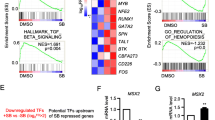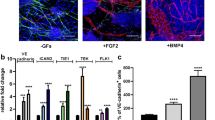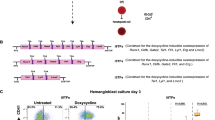Abstract
Human bone marrow-derived mesenchymal stem cells (hMSCs) have been shown to possess multilineage differentiation potential. HOX genes function in transcriptional regulators, and are involved in stem cell differentiation. The aim of the present study was to demonstrate HOX genes that are related to angiogenesis. To identify the expression patterns of 37 HOX genes in the endothelial cell differentiation of hMSCs, we analyzed HOX genes through profiling with multiplex RT-PCR. The results showed that the expression patterns of four HOX genes, HOXA7, HOXB3, HOXA3, and HOXB13, significantly changed during angiogenesis. The expression levels of HOXA7 and HOXB3 were dramatically increased, whereas those of HOXA3 and HOXB13 were decreased during endothelial cell differentiation. When further analysis of the expressions of these HOX genes was performed with real-time PCR and an immunoblot assay, the expression patterns were also found to be well-matched with the results of multiplex RT-PCR. Here, we report that HOXA7, HOXB3, HOXA3, and HOXB13 might be involved in the angiogenesis of hMSCs.




Similar content being viewed by others
Abbreviations
- hMSCs:
-
Human mesenchymal stem cells
- DMEM:
-
Dulbecco’s modified Eagle’s medium
- FBS:
-
Fetal bovine serum
- VEGF:
-
Vascular endothelial growth factor
- EGF:
-
Epidermal growth factor
- PDGF:
-
Platelet-derived growth factor
- TGF-β1:
-
Transforming growth factor-β1
- RT-PCR:
-
Reverse transcriptase-polymerase chain reaction
- mAb:
-
Monoclonal antibody
- pAb:
-
Polyclonal antibody
- VE-cadherin:
-
Vascular/endothelial-cadherin
- vWF:
-
von Willebrand factor
References
Minguell JJ, Erices A, Conget P (2001) Mesenchymal stem cells. Exp Biol Med 226:507–520
Jiang Y, Jahagirdar BN, Reinhardt RL, Schwartz RE, Keene CD, Ortiz-Gonzalez XR, Reyes M, Lenvik T, Lund T, Blackstad M, Du J, Aldrich S, Lisberg A, Low WC, Largaespada DA, Verfaillie CM (2002) Pluripotency of mesenchymal stem cells derived from adult marrow. Nature 418:41–49
Toma C, Pittenger MF, Cahill KS, Byrne BJ, Kessler PD (2002) Human mesenchymal stem cells differentiate to a cardiomyocyte phenotype in the adult murine heart. Circulation 105:93–98
Risau W (1997) Mechanisms of angiogenesis. Nature 386:671–674
Neufeld G, Cohen T, Gengrinovitch S, Poltorak Z (1999) Vascular endothelial growth factor (VEGF) and its receptors. FASEB J 13:9–22
Duprez DM, Kostakopoulou K, Francis-West PH, Tickle C, Brickell PM (1996) Activation of Fgf-4 and HoxD gene expression by BMP-2 expressing cells in the developing chick limb. Development 122:1821–1828
Goff DJ, Tabin CJ (1997) Analysis of Hoxd-13 and Hoxd-11 misexpression in chick limb buds reveals that Hox genes affect both bone condensation and growth. Development 124:627–636
van den Akker E, Fromental-Ramain C, de Graaff W, Le Mouellic H, Brulet P, Chambon P, Deschamps J (2001) Axial skeletal patterning in mice lacking all paralogous group 8 Hox genes. Development 128:1911–1921
Wang W, Lufkin T (2005) Hmx homeobox gene function in inner ear and nervous system cell-type specification and development. Exp Cell Res 306:373–379
Malicki J, Cianetti LC, Peschle C, McGinnis W (1992) A human HOX4B regulatory element provides head-specific expression in Drosophila embryos. Nature 358:345–347
Lei H, Juan AH, Kim MS, Ruddle FH (2006) Identification of a Hoxc8-regulated transcriptional network in mouse embryo fibroblast cells. Proc Natl Acad Sci 103:10305–10309
Wacker SA, McNulty CL, Durston AJ (2004) The initiation of Hox gene expression in Xenopus laevis is controlled by Brachyury and BMP-4. Dev Biol 266:123–137
Akin ZN, Nazarali AJ (2005) Hox genes and their candidate downstream targets in the developing central nervous system. Cell Mol Neurobiol 25:697–741
Abate-Shen C (2002) Deregulated homeobox gene expression in cancer: cause or consequence? Nat Rev Cancer 2:777–785
Thorsteinsdottir U, Sauvageau G, Humphries RK (1997) Hox homeobox genes as regulators of normal and leukemic hematopoiesis. Hematol Oncol Clin North Am 11:1221–1237
van Oostveen J, Bijl J, Raaphorst F, Walboomers J, Meijer C (1999) The role of homeobox genes in normal hematopoiesis and hematological malignancies. Leukemia 13:1675–1690
Mace KA, Hansen SL, Myers C, Young DM, Boudreau N (2005) HOXA3 induces cell migration in endothelial and epithelial cells promoting angiogenesis and wound repair. J Cell Sci 118:2567–2577
Myers C, Charboneau A, Boudreau N (2000) Homeobox B3 promotes capillary morphogenesis and angiogenesis. J Cell Biol 148:343–351
Myers C, Charboneau A, Cheung I, Hanks D, Boudreau N (2002) Sustained expression of homeobox D10 inhibits angiogenesis. Am J Pathol 161:2099–2109
Raman V, Martensen SA, Reisman D, Evron E, Odenwald WF, Jaffee E, Marks J, Sukumar S (2000) Compromised HOXA5 function can limit p53 expression in human breast tumours. Nature 405:974–978
Valerius MT, Patterson LT, Feng Y, Potter SS (2002) Hoxa 11 is upstream of Integrin alpha8 expression in the developing kidney. Proc Natl Acad Sci 99:8090–8095
Boudreau NJ, Varner JA (2004) The homeobox transcription factor Hox D3 promotes integrin alpha5beta1 expression and function during angiogenesis. J Biol Chem 279:4862–4868
Jaiswal N, Haynesworth SE, Caplan AI, Bruder SP (1997) Osteogenic differentiation of purified, culture-expanded human mesenchymal stem cells in vitro. J Cell Biochem 64:295–312
Gang EJ, Jeong JA, Han S, Yan Q, Jeon CJ, Kim H (2006) In vitro endothelial potential of human UC blood-derived mesenchymal stem cells. Cytotherapy 8:215–227
Jee BK, Park KM, Surendran S, Lee WK, Han CW, Kim YS, Lim Y (2006) KAI1/CD82 suppresses tumor invasion by MMP9 inactivation via TIMP1 up-regulation in the H1299 human lung carcinoma cell line. Biochem Biophys Res Commun 342:655–661
Wang G, Brennan C, Rook M, Wolfe JL, Leo C, Chin L, Pan H, Liu WH, Price B, Makrigiorgos GM (2004) Balanced-PCR amplification allows unbiased identification of genomic copy changes in minute cell and tissue samples. Nucleic Acids Res 32:e76
Choi CB, Cho YK, Prakash KV, Jee BK, Han CW, Paik YK, Kim HY, Lee KH, Chung N, Rha HK (2006) Analysis of neuron-like differentiation of human bone marrow mesenchymal stem cells. Biochem Biophys Res Commun 350:138–146
Zhao Y, Westphal H (2002) Homeobox genes and human genetic disorders. Curr Mol Med 2:13–23
Holland PW, Garcia-Fernandez J (1996) Hox genes and chordate evolution. Dev Biol 173:382–395
Boudreau N, Andrews C, Srebrow A, Ravanpay A, Cheresh DA (1997) Induction of the angiogenic phenotype by Hox D3. J Cell Biol 139:257–264
Rhoads K, Arderiu G, Charboneau A, Hansen SL, Hoffman W, Boudreau N (2005) A role for Hox A5 in regulating angiogenesis and vascular patterning. Lymphat Res Biol 3:240–252
Kuliev A, Kukharenko V, Morozov G, Freidine M, Rechitsky S, Verlinsky O, Ivakhnenko V, Gindilis V, Strom C, Verlinsky Y (1996) Expression of homebox-containing genes in human preimplantation development and in embryos with chromosomal aneuploidies. J Assist Reprod Genet 13:177–181
Naora H, Montz FJ, Chai CY, Roden RB (2001) Aberrant expression of homeobox gene HOXA7 is associated with mullerian-like differentiation of epithelial ovarian tumors and the generation of a specific autologous antibody response. Proc Natl Acad Sci 98:15209–15214
Ota T, Choi KB, Gilks CB, Leung PC, Auersperg N (2006) Cell type- and stage-specific changes in HOXA7 protein expression in human ovarian folliculogenesis: possible role of GDF-9. Differentiation 74:1–10
Nakamura T, Largaespada DA, Shaughnessy JD, Jenkins NA, Copeland NG (1996) Cooperative activation of Hoxa and Pbx1-related genes in murine myeloid leukaemias. Nat Genet 12:149–153
Afonja O, Smith JE, Cheng DM, Goldenberg AS, Amorosi E, Shimamoto T, Nakamura S, Ohyashiki K, Ohyashiki J, Toyama K, Takeshita K (2000) MEIS1 and HOXA7 genes in human acute myeloid leukemia. Leuk Res 24:849–855
Leroy P, Berto F, Bourget I, Rossi B (2004) Down-regulation of Hox A7 is required for cell adhesion and migration on fibronectin during early HL-60 monocytic differentiation. J Leukoc Biol 75:680–688
Hansen SL, Myers CA, Charboneau A, Young DM, Boudreau N (2003) HoxD3 accelerates wound healing in diabetic mice. Am J Pathol 163:2421–2431
Cazal C, Sobral AP, de Almeida FC, das Gracas Silva-Valenzuela M, Durazzo MD, Nunes FD (2006) The homeobox HOXB13 is expressed in human minor salivary gland. Oral Dis 12:424–427
Acknowledgments
This study was supported by Seoul Research and Business Development Program (10548), the Korea Research Foundation Grant (KRF-2006-013-F00018), and scholarship support from the Brain Korea 21 Project.
Author information
Authors and Affiliations
Corresponding author
Additional information
Namhyun Chung and Bo Keun Jee contributed equally to the work.
Rights and permissions
About this article
Cite this article
Chung, N., Jee, B.K., Chae, S.W. et al. HOX gene analysis of endothelial cell differentiation in human bone marrow-derived mesenchymal stem cells. Mol Biol Rep 36, 227–235 (2009). https://doi.org/10.1007/s11033-007-9171-6
Received:
Accepted:
Published:
Issue Date:
DOI: https://doi.org/10.1007/s11033-007-9171-6




